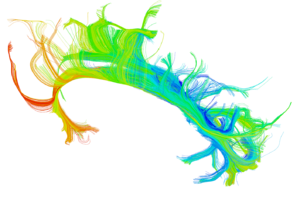Difference between revisions of "Projects:AtlasBasedDTIFiberAnalyzerFramework"
| Line 4: | Line 4: | ||
= Atlas Based DTI FIber Analyzer Framework = | = Atlas Based DTI FIber Analyzer Framework = | ||
| − | This | + | This project aims to define an automatic framework for statistical comparison of fiber bundle diffusion properties between populations of diffusion weighted images. |
= Description = | = Description = | ||
[[Image:AtlasBuilderLogo.jpg|thumb|300px|Length analysis of Cingulum tractography. Colors go from red to blue where red ones are the longest and blue ones are the shortest]] | [[Image:AtlasBuilderLogo.jpg|thumb|300px|Length analysis of Cingulum tractography. Colors go from red to blue where red ones are the longest and blue ones are the shortest]] | ||
| − | + | ||
| − | + | The general framework entails the following steps: | |
| + | |||
| + | '''DWI and DTI quality control: ''' | ||
| + | DWI data suffers from inherent low SNR, overall long scanning time of multiple directional encoding with correspondingly large risk to encounter several kinds of artifacts. These artifacts can be too severe for a correct and stable estimation of the diffusion tensor. Thus, a quality control (QC) procedure is absolutely necessary for DTI studies. | ||
| + | We developed a tool called DTIPrep which pipelines the QC steps with designated protocol use and report generation. | ||
| + | |||
| + | '''Unbiased DTI atlas building or atlas mapping''' | ||
| + | *Unbiased DTI atlas building | ||
| + | *Mapping of an existing DTI atlas | ||
| + | |||
| + | '''Tractography within 3D Slicer''' | ||
| + | * 3D Slicer modules: Label seeding and ROI select | ||
| + | * Tractography with unscented kalman filter | ||
| + | |||
| + | |||
| + | '''Fiber cleanup/clustering: ''' | ||
| + | FiberViewerLight enables several clustering methods: Length, Gravity, Hausdorff, and Mean methods but also a Normalized Cut algorithm. | ||
| + | |||
| + | |||
| + | '''DTIAtlasFiberAnalyzer''' | ||
| + | |||
| + | '''Statistical analysis performed by statistician''' | ||
| + | |||
| + | '''Merging statistics back to the original fiber bundle''' | ||
| + | MergeStatWithFiber - an application part of DTI Fiber Tracts Statistics package-, allows population statistical information to be merged back to the atlas fiber bundle. | ||
| + | |||
| + | '''3D visualization within 3D Slicer''' | ||
| + | Statically significan group differences can directly be displayed on a fiber bundle in 3D Slicer. | ||
| + | |||
= Publications = | = Publications = | ||
= Key Investigators = | = Key Investigators = | ||
| − | * UNC Algorithms: Jean-Baptiste Berger, Benjamin Yvernault, Clement Vachet, Yundi Shi, Martin Styner | + | * UNC Algorithms: Jean-Baptiste Berger, Benjamin Yvernault, Clement Vachet, Yundi Shi, Aditya Gupta, Martin Styner |
| + | * Utah Algorithms: Anuja Sharma, Sylvain Gouttard, Guido Gerig | ||
= Links = | = Links = | ||
| + | *[http://www.niral.unc.edu/download-software UNC NIRAL software download page] | ||
| + | *[http://www.nitrc.org/projects/dti_brain_atlas Human brain DTI atlas] | ||
[[Category: Diffusion MRI]] | [[Category: Diffusion MRI]] | ||
Revision as of 22:39, 28 November 2011
Home < Projects:AtlasBasedDTIFiberAnalyzerFrameworkBack to UNC Algorithms
Atlas Based DTI FIber Analyzer Framework
This project aims to define an automatic framework for statistical comparison of fiber bundle diffusion properties between populations of diffusion weighted images.
Description
The general framework entails the following steps:
DWI and DTI quality control: DWI data suffers from inherent low SNR, overall long scanning time of multiple directional encoding with correspondingly large risk to encounter several kinds of artifacts. These artifacts can be too severe for a correct and stable estimation of the diffusion tensor. Thus, a quality control (QC) procedure is absolutely necessary for DTI studies. We developed a tool called DTIPrep which pipelines the QC steps with designated protocol use and report generation.
Unbiased DTI atlas building or atlas mapping
- Unbiased DTI atlas building
- Mapping of an existing DTI atlas
Tractography within 3D Slicer
- 3D Slicer modules: Label seeding and ROI select
- Tractography with unscented kalman filter
Fiber cleanup/clustering:
FiberViewerLight enables several clustering methods: Length, Gravity, Hausdorff, and Mean methods but also a Normalized Cut algorithm.
DTIAtlasFiberAnalyzer
Statistical analysis performed by statistician
Merging statistics back to the original fiber bundle MergeStatWithFiber - an application part of DTI Fiber Tracts Statistics package-, allows population statistical information to be merged back to the atlas fiber bundle.
3D visualization within 3D Slicer Statically significan group differences can directly be displayed on a fiber bundle in 3D Slicer.
Publications
Key Investigators
- UNC Algorithms: Jean-Baptiste Berger, Benjamin Yvernault, Clement Vachet, Yundi Shi, Aditya Gupta, Martin Styner
- Utah Algorithms: Anuja Sharma, Sylvain Gouttard, Guido Gerig
